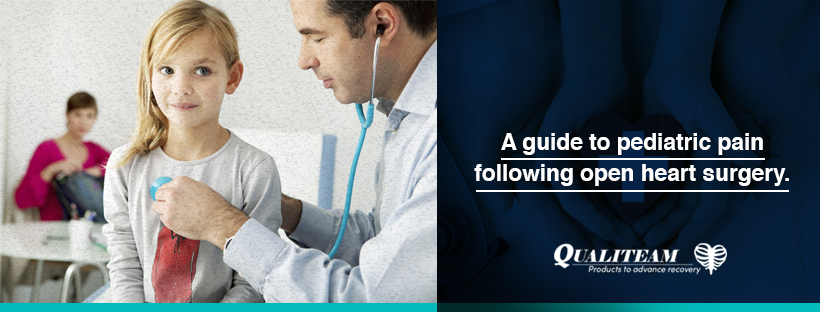When children require major heart surgery a large weight of stress comes upon the family from many different directions. Beginning with the burden of worry over their child’s well being, possible complications/risks, to how to maneuver work situations that may need to be adjusted. The anxiety that the child may feel is heightened drastically by the parents level of stress.
“Preoperative anxiety in young children undergoing surgery is associated with a more painful postoperative recovery and a higher incidence of sleep and other problems.” (1)

The pediatric population is just as susceptible to pain and anxiety factors as adults, and even more to the long term effects of pain if not treated appropriately. Parents (or caretakers) play a large role in the decisions for a child’s recovery, and are the advocates on behalf of the child wanting to give comfort in any way possible.
Inclusion of the parent in deciding the plan for the child’s pain relief, postoperative therapy planning and home going is a necessity. Pediatric pain lacked research until 15-20 years ago when premature infants were studied for responses to painful stimuli. Researchers began to understand the need for more insight into pain levels in children of all ages.
“A recent bibliometric analysis of research articles on pediatric pain published during the period from 1975 to 2010 showed exponential growth in the field with an increasingly multidisciplinary approach, and the most popular areas of focus being characterization, intervention, and assessment of pain.”(2)
While knowledge has expanded on the subject, implementation in the clinical atmosphere is still needed to fully understand what children may experience related to pain and how to best manage it.
 The first step in identifying pain in children is knowing which assessment tool to use, and in which clinical setting it is best. As shown in the chart there are different tools for different age categories such as FLACC, NIPS/PIPP, PAL, FPS/Wong-Baker, and NCCPC. Also, below are examples of the most frequently used scales for children.
The first step in identifying pain in children is knowing which assessment tool to use, and in which clinical setting it is best. As shown in the chart there are different tools for different age categories such as FLACC, NIPS/PIPP, PAL, FPS/Wong-Baker, and NCCPC. Also, below are examples of the most frequently used scales for children.


The scales may be used in many different settings and modified to the appropriate developmental stage of the child. Being familiar with all these can let healthcare professionals and parents work together to assess pain in the child.
Easing anxiety can be started preoperatively, with a simple stuffed animal/character. It gives the child something physical to hold and feel secure with.
One current study informs us that “providing toys for children and informing the parents about medical information has a major effect in reducing children's and other's anxiety” (3)
Giving a feeling of security to the child increases parental satisfaction that staff is aimed at consoling the child even before the surgery. Alternative ideas can include coloring books on the surgery being done, puzzles putting “pieces” back together, or digital games to repair body parts. Providing educational information on their level of development eases the question of the unknown.
 Following surgery, it is imperative to be comforting and reassuring to the child, and by speaking to them in a soothing voice. Encouraging your child to eat and to be as active as possible, according to direction from the doctor and physical therapist will help speed along the recovery process. It has been backed with clinical evidence that providing external chest support to adults can lessen pain significantly, decrease the chance of sternal infections, and post-surgery complications. (4) The pediatric population is just as susceptible to all of these factors, and even more for long term effects of pain if not treated appropriately. Commonly, pain relief without pharmacological intervention is the said choice of parents, caregivers, and staff. Many parents worry about their child taking opioids. They may fear that a child who takes opioids will become addicted or learn to rely on drugs. Addiction in young children is extremely rare when taken for severe pain and under doctors strict care. Strong pain requires strong medicine even for children.
Following surgery, it is imperative to be comforting and reassuring to the child, and by speaking to them in a soothing voice. Encouraging your child to eat and to be as active as possible, according to direction from the doctor and physical therapist will help speed along the recovery process. It has been backed with clinical evidence that providing external chest support to adults can lessen pain significantly, decrease the chance of sternal infections, and post-surgery complications. (4) The pediatric population is just as susceptible to all of these factors, and even more for long term effects of pain if not treated appropriately. Commonly, pain relief without pharmacological intervention is the said choice of parents, caregivers, and staff. Many parents worry about their child taking opioids. They may fear that a child who takes opioids will become addicted or learn to rely on drugs. Addiction in young children is extremely rare when taken for severe pain and under doctors strict care. Strong pain requires strong medicine even for children.
 Pain can be addressed as healing begins, and medications adjusted if needed. Amendments to activities are alternative aids in providing relief. Purpose-designed external chest supports such as QualiBreath for the pediatric population give circumferential chest support with built-in on-demand reinforcement. This helps alleviate pain associated with coughing, sneezing, and strain with movement. It is the only chest binder for chest surgeries that is dual functioning. These binders will be placed immediately after surgery to give comfort to the child, and can be worn as long as is needed to return to their usual daily activity, without putting additional stress on their chest incision.
Pain can be addressed as healing begins, and medications adjusted if needed. Amendments to activities are alternative aids in providing relief. Purpose-designed external chest supports such as QualiBreath for the pediatric population give circumferential chest support with built-in on-demand reinforcement. This helps alleviate pain associated with coughing, sneezing, and strain with movement. It is the only chest binder for chest surgeries that is dual functioning. These binders will be placed immediately after surgery to give comfort to the child, and can be worn as long as is needed to return to their usual daily activity, without putting additional stress on their chest incision.
 Recovery at home will be discussed when planning the child’s discharge from the hospital. The length of stay varies as each child recovers at different rates, typically 4-7 days depending on factors such as pain levels, lab values, pulmonary status, activity status, and medication tolerance. Parents (caregivers) are provided detailed education on medication administration, follow-up care, and expected activity progress. Below are some guidelines to review with the multidisciplinary team:
Recovery at home will be discussed when planning the child’s discharge from the hospital. The length of stay varies as each child recovers at different rates, typically 4-7 days depending on factors such as pain levels, lab values, pulmonary status, activity status, and medication tolerance. Parents (caregivers) are provided detailed education on medication administration, follow-up care, and expected activity progress. Below are some guidelines to review with the multidisciplinary team:
->what to expect during the first few weeks
->how active your child should be during this period
->how you can help your child when they are in pain
->when your child needs to come back for a visit to check on their recovery and overall progress
->whether your child needs to do exercises at home to help improve their physical abilities
->who to contact if you have any questions
It can be very normal for you to notice some changes in your child’s behavior as they adjust to being in the healing process. Signs of increased pain may be seen as irritation with simple tasks, paleness, restlessness, and increased impatience. Monitoring the behavior of the child can give insight into how they may be feeling physically. Keeping an open communication style or using a pain chart at home can be beneficial to both the child and parents. It's important to have your child regularly monitored, even if treatment was very successful and your child is feeling healthy because the heart can change over time. Implementing some simple lifestyle changes (nutritious food, exercise, stress relief, etc) starting when they get home from the hospital leads to ongoing heart healthiness.
While some children do recover faster or tolerate higher pain levels than adults, children with multiple medical conditions are prone to increased risk of complications. When a child has undergone major chest surgery, their pain must be taken seriously. It can only benefit children to promote a quicker, smoother recovery when they require open chest surgery that they are given optimal pain relief options to get them back to their playful happy self as soon as possible.
References:
- Zeev N. Kain, Linda C. Mayes, Alison A. Caldwell-Andrews, David E. Karas, Brenda C. McClain “Preoperative Anxiety, Postoperative Pain, and Behavioral Recovery in Young Children Undergoing Surgery” https://pediatrics.aappublications.org/content/118/2/651.short
- Caes L, Boerner KE, et al. “A comprehensive categorical and bibliometric analysis of published research articles on pediatric pain from 1975 to 2010”. PAIN 2016;157:302–13.
- Ghabeli F, Moheb N, Nasab S. Effect of Toys and Preoperative Visit on Reducing Children's Anxiety and their Parents before Surgery and Satisfaction with the Treatment Process. J Caring Sci. 2014 Mar; 3(1): 21–28. https://www.ncbi.nlm.nih.gov/pmc/articles/PMC4134164/
- El-Ansary D, Aitken J, Zalucki N, Hardikar A, Clinical management and rehabilitation of persistent sternal instability 2015. https://www.magonlinelibrary.
com/doi/abs/10.12968/ijtr. 2015.22.9.443 -
Adams J, Lotshaw A, et al., An alternative approach to prescribing sternal precautions after median sternotomy, “Keep Your Move in the Tube” 2016 Jan; 29(1): 97–100. https://www.ncbi.nlm.
nih.gov/pmc/articles/ PMC4677872/


5 comments
Aug 08, 2019 • Posted by Kim Shockley
This product for the pediatric patient s/p cardiac procedures is very innovative. Having practiced as a Pediatric Physical Therapist this is an awesome product I would have loved to use with my patients. Educating and familiarizing parents and patients before the surgery always puts everyone at ease.Outcomes with this product should be ground breaking.
Jul 18, 2019 • Posted by Al Seck
Very comprehensive and informative article about a relatively small (pun intended) but extremely important subset of patients who in many cases can’t speak for themselves. Therefor extremely valuable to have this well documented information to guide/ remind professional caregivers in the care of these very vulnerable, very special patients.
Jul 15, 2019 • Posted by Robbie Blackwood
A very insightful article that shows the advancement of post surgical care for paediatric patients.
Jul 15, 2019 • Posted by Alice Jones
Very useful information. Restriction to upper limb movements after sternotomy is debatable; a product which is able to support the wound during coughing and sneezing would be ideal, as long as it does not limit lung expansion.
Jul 15, 2019 • Posted by Dermot Lynch
This is a very insightful & useful article. It is hard to believe how far we have come with research & pediatric health studies over the last 20 years. Luckily there are treatments & innovative post operative products such as QualiBreath which go along way to develop pediatric care & well-being into the future.
Leave a comment: